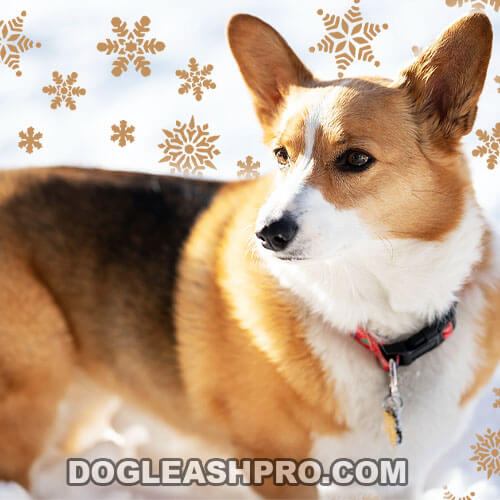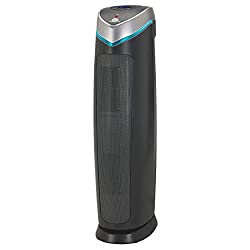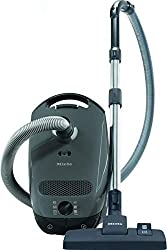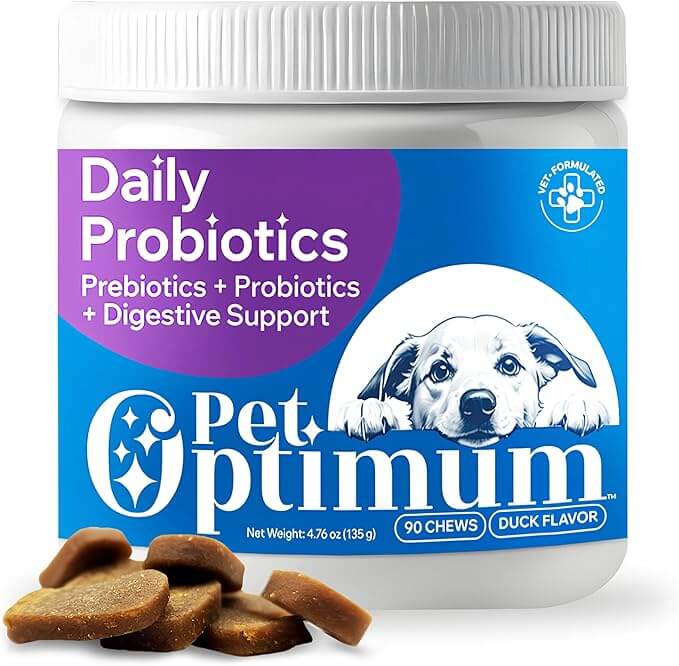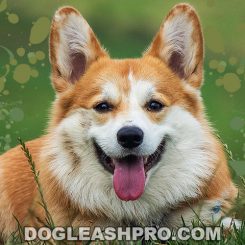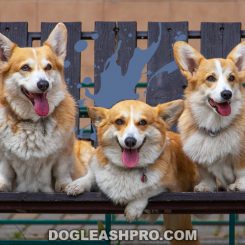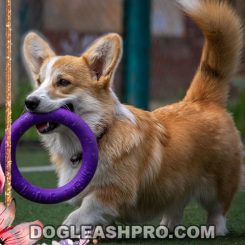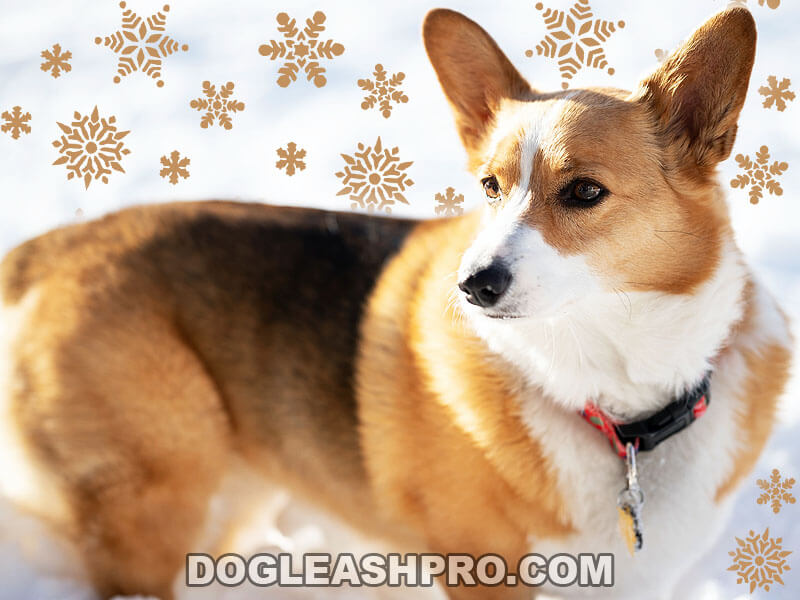
Most canine enthusiasts have preferences regarding doggy coat colors and Sable is a coveted coat color amongst Corgi lovers. If you’re a prospective Corgi owner looking for more information on the Sable Corgi, you’ve come to the right place.
This comprehensive guide will take an in-depth look at what makes Sable Corgis special. We’ve covered everything from history and genetics to color progression and personality. There’s also a helpful FAQ section to answer all your specific questions.
A Sable Corgi, much like a Red Corgi, will be able to participate in dog shows, provided that he conforms to the required criteria mentioned in the breed standard. That’s just one of many interesting facts about Sable Corgis. To learn more, grab a comfy seat and keep scrolling!
Table of Contents
Sable Corgi: Breed overview
If you’re looking for some quick and easy facts about Sable Corgis, our breed overview table can help.
| Common Names | Sable Corgi |
| Purity | High |
| Purpose | Family Dog, Companion Canine |
| AKC Recognition | Yes |
| Size | Small-to-medium |
| Weight | 24-38 pounds |
| Height | 10-13 inches |
| Coat Colors | Sable |
| Child Friendliness | High |
| Feline Friendliness | Medium |
| Training Difficulty | Medium-to-easy |
| Grooming Upkeep | Moderate-to-high |
| Exercise Needs | High |
What is a Sable Corgi?
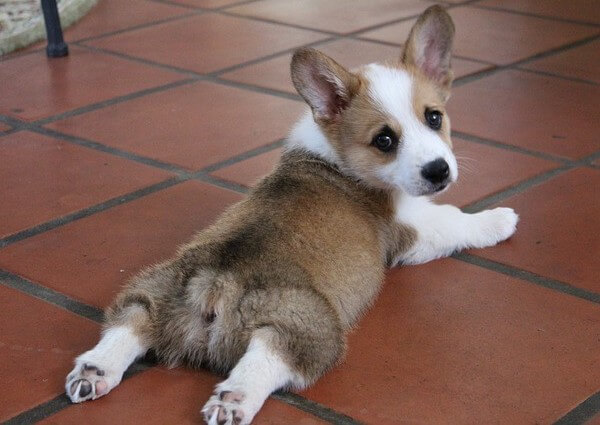
A Sable Corgi gets his name thanks to his unique coat coloring. It has a white base coat with dark red hair. The red fur is typically found on the Corgi’s back and includes black hair, which makes the canine appear darker on top.
Is the Sable Corgi rare?
As unique as Sable Corgis look, they are not very rare. Sable is a recognized coat color among the Corgi breed, along with red, brindle, fawn, black, and tan.
In other words, there are (or have been) plenty of Corgis with similar hues for canine registries to make Sable a part of the official breed standard.
If you’re new to the dog-keeping community and don’t know what a breed standard is, allow us to explain.
Simply put, breed standards contain the description of an ideal canine from a specific breed. These characteristics can vary depending on the breed and its purpose. The more standards a dog conforms to, the better it will perform in a conformation show.
Cardigan Welsh Corgi history
The Welsh Corgis consist of Cardigan Welsh Corgis and Pembroke Welsh Corgis. Cardigan Corgis are the older of the two distinct canine breeds. They’re often referred to as the Corgis with tails.
Cardigan Corgis are slightly bigger and have a heavier bone structure than Pembroke Corgis. Since they were initially bred to be herding dogs, they have a lot of stamina, agility, and speed.
Cardigan Corgis are counted among the oldest dog breeds of the British Isles.
Additionally, Pembroke Corgis have fox-like features, but their ears are more prominent and rounded at the tips.
Other renowned features of this Corgi breed include low-set and long bodies and plumed tails. They also have medium-length double coats and are available in Sable, red, and brindle shades.
Temperament-wise, Cardigan welsh Corgis are intelligent, eager to please, and high-spirited. As high-energy canines, they also have a particular fondness for playtime.
Pembroke Welsh Corgi history
Pembroke Welsh Corgis were bred to be cattle-herding dogs. The breed originates from Pembrokeshire, Wales.
Pembrokes were always popular, but they became quite popular after they received the patronage of Queen Elizabeth II, who owned more than 30 Corgis during her lifetime.
Pembroke and Cardigan Corgis were recognized by the Kennel Club in 1928 but were recognized as two different breeds in 1934.
Pembroke Corgis are easily distinguished from their Cardigan counterparts, thanks to their docked tails. These canines are also slightly smaller in size and have more outgoing and friendly personalities.
They are high-energy dogs, love playing, and are incredibly loyal to their families. Pembrokes are also easy to train due to their high intelligence.
Cardigan Welsh Corgi vs Pembroke
The main difference between Cardigan Welsh Corgi and Pembroke is that Cardigan Welsh Corgi is bigger in size while Pembroke Welsh Corgi is medium-boned and shorter.
Besides that, Cardigan Corgis also have furry, fox-like tails, whereas Pembroke Corgis have docked tails.
Sable Corgis physical appearance
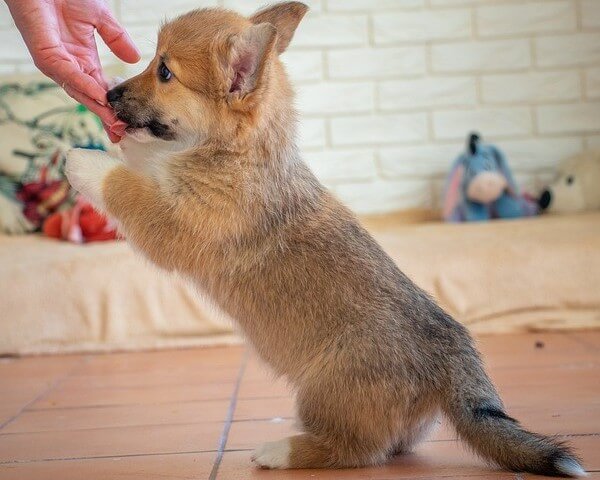
If you’re a fan of Sable colored Corgi, you’ll be happy to learn that Sable is a recognized color for both Cardigan and Pembroke Welsh Corgis. This also means that Sable Corgis can vary in physical appearance based on their Corgi breed.
Keep reading to discover the physical characteristics of the Sable Corgis.
Sable Pembroke Welsh Corgi
A Sable Pembroke Corgi won’t differ much in coat color from a Sable Cardigan Corgi. The Pembroke welsh Corgi Sable has a white base coat and red fur with black patches on his head and back.
The Sable coloring is darker towards the topline and becomes a lighter shade of red as it descends to the thighs and shoulders.
The Pembroke Sable Corgi also has dark-colored ears and, sometimes, a widow’s peak on their foreheads.
You can also expect the Pembroke welsh Corgi colors Sable to differ from canine to canine.
Sable Corgis gets their dark mahogany appearance from their black shaded patches of hair. That means pups with more black fur might look different from those with a nominal amount of black fur.
Finally, the Pembroke Corgi Sable has a docked tail, although breed standards allow for a tail up to two inches.
Sable Cardigan Welsh Corgi
The Sable cardigan Corgi will look much like a Pembroke Corgi in terms of color. That includes a white base color and red fur with black hair. However, the welsh Corgi Sable will also have a plumed tail with red and white fur. These Corgis also have large rounded ears and black nose.
Are Sable Corgi recognized by AKC?
Yes, the Sable Corgi is recognized by the American Kennel Club (AKC). The AKC recognizes Sable as a coat color for Pembroke and Cardigan Corgis.
Sable Corgi genetics
Canine experts have uncovered quite a lot about dog coat colors and how genetics plays a factor in determining them. However, when it comes to the Sable Corgi color, very little is known.
Geneticists still need to identify the gene responsible for the Sable coloring. Although, experts state that Sable can be a combination of the ay (red), ay- (weak red), atR (red-headed tricolor), and atb (black-headed tricolor) genes.
If a Corgi inherits the ay- and atb genes, he may have a light Sable coloring, whereas the ay and atR genes produce a dark Sable coloring.
Sable Corgi color progression
It’s not uncommon for canines to experience color progression throughout their lives.
Some pups with lighter hair can grow up and have darker fur while other puppies with dark hair can lose their color intensity as they grow older.
The Corgi Sable color change is, therefore, a natural phenomenon. Your Sable Corgi puppy can grow up to lose his Sable coloring and become a red and white Corgi instead. This is because dogs will generally grow out their adult coat until the 24-month mark.
At times, a dark Sable color Corgi can transform into a light Sable coat color. Pet parents can only be sure about their fur baby’s true colors once he reaches adulthood and develops his adult coat.
Sable Corgi puppy progression
The Corgi Sable color in pups generally changes from dark to light. Corgi puppies with red and black fur and a white base coat are considered Sable.
Nonetheless, the black hair can lighten and blend in with the red. This is a much more common color among the Corgi breed.
But before you get too anxious thinking your Sable Corgi pup might lose his brilliant hue, you should know that not all puppies will change colors.
Some puppies will keep their Sable coloring, while others might only experience minimal color progression and lose black fur in certain parts of their body.
For instance, puppies born with a widow’s peak on their forehead can lose the dark coloring on their heads.
Sable Corgi coat color and types
Does your search history include the term ‘Corgi colors Sable?’ If yes, then this section might interest you. According to the AKC breed standard, Corgis have medium-length fur and double coats.
Their outercoats are slightly harsh in texture, whereas the undercoats are dense and smooth. Both Pembroke and Cardigan Corgis also have a light ruff near the neck and chest, and their hair is slightly longer around the hind legs and underparts.
Here are some of the coat colors among the Corgi breeds.
Red: This is a dominant color among Pembroke Corgis, with several variations common among the breed. Red Corgis have red fur on their heads and bodies with white fur around the muzzle, neck, chest, and underparts.
Fawn: Fawn-colored Corgis are lighter than their red counterparts and appear closer to a creamy latte color.
Sable: Sable-colored Corgi have red coats with black fur around the topline. They can be either light Sable or dark Sable. They also have a white base coat, which is why canine experts believe the genes for the Sable coloring have something to do with the red-headed tricolor and black-headed tricolor genes.
Black and white: This color combination is more common among Cardigan Corgis. They are dual-colored with white and black fur on their bodies.
Fluffy Sable Corgi
The Sable Fluffy Corgi has a longer and fluffier coat compared to normal Corgis due to a genetic mutation. The mutation occurs because of a recessive gene, which means both parents need to be carriers for the fluffy coat to materialize in puppies.
Sable Fluffy Corgis have white, red, and black fur, but the only difference is that their coat length is longer than the standard Corgi.
Red Sable Corgi
Red Sable Corgis have red and black fur on their head and bodies. However, they have more red hair than black hair, especially around the ears. These canines also have white base coats, which is why they’re also referred to as red-headed tricolors.
Sable vs red Corgi
Red and Sable Corgis are pretty similar in coat colors, except that Sable colored Corgis have red fur with black patches while red Corgis have a combination of white and red fur, with no other color patches.
Sable and white Corgi
The Sable white Corgi is mainly red but with well-blended patches of black fur around the head and neck areas. Corgi Sable and white also have white fur on his chests and underbelly. The Cardigan welsh Corgi colors Sable & white are recognized by the AKC.
Dilute Sable Corgi
The term ‘dilute’ in the Corgi breed is used to describe canines with the dilution gene. If both parents are carriers of the said gene, the puppies can develop washed-out colors that appear to have a greyish tinge.
The dilute Sable Corgi is born with grey fur and retains a greyish tinge to its Sable-colored coat as an adult. Dilute Sables can also have hazel or light blue eyes.
Blue Sable Corgi
Blue Sable Corgis have a light grey tinge to their coat. This can make their red, black, and white fur appear somewhat muted.
Sable bluie Corgi
Bluie is another term for dilute. Therefore, Sable bluie Corgis are similar to dilute Sable Corgis; that is, these dogs have a white base layer with red fur and black patches. But, since both parents have the dilution gene, their Sable colors aren’t as intense.
Sable merle Corgi
Sable merles mainly have Sable coloring, but you can notice the merle or marbling effect because of dark patches of fur on specific areas of the Corgi’s body.
Dark Sable Corgi
Dark Sable Corgis get their name because they generally have a more significant concentration of black fur patches. These fur babies have the generic red, black, and white colors but appear darker than other Sables.
Light Sable Corgi
Light Sable Corgis have Sable hues, too, with the distinct difference that their coats don’t have too much black coloring. This makes them appear lighter in color overall.
Corgi Sable size, height, and weight
If you’re wondering about the dimensions of Sable Corgis, we’ve got you covered. Scroll down to discover what you can expect of the Sable Corgis regarding their height and weight.
Sable Pembroke Welsh Corgi
Pembroke Corgis and Cardigan Corgis differ in size, height, and weight. The former are slightly smaller, medium-boned, and the more popular breed worldwide.
| Height | Weight | Length | |
| Male | 10-12 inches | 24-31 pounds | 22-26 inches |
| Female | 10-12 inches | 24-28 pounds | 22-26 inches |
Sable Cardigan Welsh Corgi
Cardigan Corgis are more muscular in appearance, and they also sport the fluffy fox-like tails. They generally weigh more than their Pembroke Corgi cousins.
| Height | Weight | Length | |
| Male | 10-13 inches | 30-38 pounds | 23-27 inches |
| Female | 10-13 inches | 25-34 pounds | 23-27 inches |
Sable Corgi temperament and personality
Sable Corgis are playful, agile, and loving dogs. These canines are also highly loyal and intelligent, making them easy to train.
These fur babies require plenty of physical and mental stimulation to stay healthy. Since Corgis were bred to be herding dogs, they have deep energy reserves.
If they don’t receive enough exercise or are left alone for long, they can develop behavioral issues.
Do Sable coat Corgi make great family pets?
Yes, the Sable coat Corgis do make great family pets. They are extremely affectionate with family members and young children. They’re highly tolerant, have indulgent personalities, and have little to no aggression. Corgis also get along well with other pets, making them ideal family dogs.
Sable welsh Corgi training
The Sable welsh Corgi is an intelligent canine breed, making them easy to train because they pick up verbal and visual cues pretty fast.
Still, if you’re a first-time canine parent, it’s best to enroll your fur baby in the nearest canine obedience school to understand how dog training works.
Once you’ve gotten the hang of using positive reinforcement to teach your Corgi acceptable behavior and tricks, you can start training him at home.
SEE ALSO: How to Crate Train A Puppy in 6 Steps
Sable Corgi exercise requirement
Corgis require at least 60 minutes of daily exercise to achieve optimal levels of mental and physical health. Keep in mind that this is a high-energy dog breed, which means they can act out and develop destructive behaviors if their pent-up energy isn’t given a healthy outlet for release.
Destructive behavioral issues can be chewing on furniture, sofa, or shoes in your home. If you notice your Corgi resorts to chewing as a way to release their pent up energy or due to stress or anxiety, try giving him a dog bone or two.
It’s best to bring them outside for a walk every day. Corgi owners can break down the 60-minute daily exercise requirement into smaller segments throughout the day. For instance, 30-minute walks during dawn and dusk hours will work just as well.
When walking your K9 friends, be sure to use a retractable dog leash so you have full control over them while still giving them enough space to explore and walk.
Sable Corgi ideal living conditions
Corgis do well in apartments and multi-story houses due to their relatively small and compact size. They love cuddling with their owners and don’t have excessive space requirements.
In fact, if you place a Corgi near a window to observe the world outside, he can actually sit there for hours. Corgis are adaptable and highly protective of their families, which helps them adapt to most types of living conditions.
However, if you have a large family, this is best because Corgis don’t do too well if left alone for long periods of time. A household where Corgis have constant companionship is ideal for the breed.
If you have a spacious backyard, it’s a good idea to let your little pup play outside and roam freely. However, make sure that your yard is fully fenced-in so your furry family members are safe.
It is important to point out that some towns or counties have zoning laws that prohibit putting up physical fences. If you’re in this situation, don’t fret!
A great alternative would be to install a wireless dog fence which will also keep your furry companions safe and contained within your backyard.
What’s great about the invisible doggy fence is that it is flexible and adaptable to any and all types of terrains, is cost-efficient, and very easy to install. Best of all, you can now enjoy your beautiful backyard view without comprising on the safety of your dogs.
If you do let your pups play outside in your yard during the day, we highly recommend getting an electronic dog door so your canine friends can head outside and come back into the house on their own.
Many Corgi owners love the automatic doggy door because it is programmable and you customize curfew hours. This way your furry friends can enjoy the outdoors during the day while staying safe indoors at night.
So whether you work from home or at the office, your K9 companions can head outside on their own without having you to open and close the door behind them. What a time-saver!
Sable Corgi grooming and cleaning
Corgi dogs may be double-coated, but they’re not too taxing when it comes to their grooming needs. If you own a standard (not Fluffy) Corgi, we recommend brushing him daily with a slicker brush which will help to get rid of debris and hair from your Corgi’s double coat.
During heavy shedding seasons like the fall and spring, you’ll want to a FURminator de-shedding tool as the slicker brush might not be as effective in removing all the hair.
All of this can help keep shedding to a minimum and promote coat health.
When it comes to keeping your Corgi’s coat clean, you can simply use doggie wipes to keep their coat, paws, skin, and face clean after a long walk. You don’t want to bathe your furry friends too often as doing so can cause dry, itchy, irritated, and inflamed skin.
When you do bathe your Corgi, you’ll want to use an organic dog shampoo that contains natural ingredients. The best doggy shampoo is one that not only cleanses your pup’s skin and coat, but also leave them moisturized and healthy.
Next, it’s essential to brush your Corgi’s teeth daily with a dog toothpaste that contains an enzymatic formula. This is crucial because the enzymatic formula helps to break down plaque, control tartar formation, and keep your pup’s pearly white clean and healthy.
Lastly, don’t forget to trim your pup’s nails before they grow too long. If your pooch is sensitive to the clipping noise, try using a dog nail grinder instead because it is quiet and features a precise diamond drum bit grinder.
Here are other relevant grooming techniques for the breed.
| Grooming Technique | Grooming Frequency |
| Hair Brushing | 1x daily: 10 mins (Fluffy coat), 3x weekly: 15 mins (Standard coat). |
| Bathing | Every four weeks or as needed. |
| Nail Trimming | Every three weeks or as required. |
| Teeth Brushing | 1x daily. |
| Eye Care | Wipe the crust around the eyes once daily. |
| Ear Care | Once a month. |
Is the Sable Corgi hypoallergenic?
No, Sable Corgis are not hypoallergenic. That’s because Corgis are medium-length double-coated dogs. The same is true for Sable Corgis because ‘Sable’ is a coat color. It has no bearing on the canine’s coat type.
If you or anyone in your family is allergic to dander, fur, or pollen, we recommend getting an air purifier with HEPA filter and UV light filters. This can help to remove dust, dander, fur, germs, and odor from the air.
WANT MORE INFORMATION? Check out Are Corgis Hypoallergenic?
Do Sable Corgis shed?
Corgis experience moderate shedding throughout the year, with heavy shedding periods in the fall and the spring.
During the ‘blow out’ season, Corgis will shed a lot of hair from their undercoats. During this time, they require extensive brushing with slicker and de-shedding brushes (as we discussed above) to control the spread of hair.
If the amount of fur that’s shed throughout the year and during the shedding seasons annoy you, it may be a good idea to invest in a powerful and durable vacuum cleaner.
In my family of two dogs, we trust the Miele vacuum cleaner because it does a wonderful job at getting rid of pet fur and dander. Best of all, it can seamlessly transition from hardwood floor and carpet. The accessories provided will help you clean hard to reach places.
RECOMMENDED: Do Corgis Shed? 15 Tips to Manage Corgi Shedding!
Sable Corgi food and diet
A healthy and nutritious diet for your canine friends offers multiple benefits. These include immunity, a healthy digestive system, optimal growth patterns, and coat and skin health.
Besides protein, fat, carbohydrates, mineral, vitamins, and water, Corgis require top-quality pet food.
The better the quality of a brand, the better chances your pet has of avoiding filler such as corn or wheat, which can lead to canines developing food allergies.
In addition to high-quality dog food, incorporating supplements like PetOptimum Probiotics for Dogs can further support your Corgi’s digestive health. With a blend of prebiotics and probiotics, these supplements are designed to promote a balanced gut, aiding nutrient absorption and overall well-being.
For the best results, we recommend speaking with your vet to ensure your dog’s diet and supplements are tailored to their unique needs, giving your fur baby maximum health advantages.
Sable Corgi health problems
Corgis are susceptible to several health concerns. Here are some health problems relevant to the breed that owners need to be aware of.
Canine obesity
Sable Corgis are high-energy canines and require ample exercise to stay fit. Lack of exercise can result in these canines becoming overweight, which can cause secondary health concerns like diabetes or digestive problems.
Food Allergies
Corgis have sensitive tummies and can develop food allergies to ingredients like dairy, grains, soy, and other ingredients.
RELATED: How to Get Your Dog to Eat When Sick
Back Concerns
Low-set dogs like Corgis with long backs are prone to developing Intervertebral Disc Disease (IDD). This condition generally develops when the cushion between the vertebrae slips or ruptures. It’s a painful orthopedic condition that will require veterinary assistance.
Hip Dysplasia
Corgis are at risk of developing diseases like hip dysplasia and elbow dysplasia. This is an inherited health condition that can be avoided if pet parents take proper precautions such as a nutritious diet and supplements that promote skeletal health and preventing over-exercise in puppies.
Cataracts
Dogs can develop cataracts due to age, injury, or diabetes. This condition can worsen and lead to partial or complete blindness. Thankfully, surgically removing cataracts can help Corgis regain their normal eyesight.
READ NEXT: How To Soften Dog Eye Boogers?
Sable Corgi lifespan
Corgi (both Pembroke and Cardigan) have an average life span of 12 to 15 years.
Sable Corgi breeder
Experts recommend approaching reputable Corgi breeders to acquire a pup instead of from a pet store. Similarly, pet lovers who want to bring home a Sable Corgi should look up Corgi breeders in their area.
Breeders not only have their dames and sires DNA-tested for congenital disorders, but they also adhere to ethical standards in housing and raising their puppies, which results in healthier fur babies.
Sable Corgi puppy
Pet lovers on the lookout for Sable Corgi puppies may have to be patient and wait for a little before they get to bring home their furry companion. That’s because it’s best to let pups stay with their mother and littermates until they are at least two months of age.
This allows the puppies to pick up essential grooming skills and playing behaviors that help them mature into well-behaved adults. Moreover, it also helps the little fur babies pick up early socialization and house training.
Sable Corgi price
A Sable Corgi pup can cost between $400 and $4,000, depending on popularity, breeder quality and location, canine bloodlines, and other factors.
Places to find Sable Corgi puppies for sale
Looking for Sable Corgi puppies for sale? If yes, this section contains breeder details that can help you get a kickstart.
If you’re based in California, Noble Hearts Corgis (nobleheartscorgis.com) is an excellent place to start your search for a Sable Corgi puppy for sale. They offers a five-year health guarantee for all their Corgi puppies.
If you’re in New York, check out Hudson Valley Corgis (hudsonvalleycorgis.com). They are members of the American Kennel Club (AKC). All the pups at Hudson Valley are raised at home to ensure they are house-trained and ready to adapt to their future fur-ever homes.
Harman Corgis (harmancorgis.com) is based in Texas and have quite a few Sable and white dames on their breeding list. All of their pups come with health guarantees, and the parents are DNA-tested to ensure they are free of congenital diseases.
Finding a healthy Sable Corgi for sale
Pet lovers searching for an adult Sable Corgi for sale might want to go through this section. That’s because this section includes breeder details where you can locate your very own adult Sable Corgi.
Noble Hearts Corgis (nobleheartscorgis.com) is pretty special because you can find both puppies and adult Corgis for sale. Since they offer Sable and white pups, it’s highly likely one (or more) of their adult Corgis have the same coloration.
F&M Corgi’s (fmcorgi.com) is located in Mulberry, Kansas. They’re a family-run operation and offer various colored Corgis, including Sable adults.
Stony Creek Pembroke Welsh Corgi’s (stonycreekpembrokecorgi.com) is based in Romeo, Michigan. They’re a good bet if you’re searching for adult Sable Corgis with excellent health guarantees.
Sable Corgi: Pros and Cons
Bringing a fur-ever pup home isn’t an easy decision. That’s why we’ve created a pros and cons table to help you with your decision-making.
| Pros | Cons |
| Good with kids and pets. | Can be pretty vocal (barking). |
| Easy to train. | Can’t be left alone for a long time. |
| Affectionate and loving. | Susceptible for certain health concerns. |
| Protective nature. | Requires ample mental stimulation. |
| Highly Intelligent. | Needs a strict exercise schedule. |
| Apartment-friendly. | High-energy dog. |
Is the Sable Corgi right for me?
Corgis are excellent family pets. But, they’re more suitable for a large family or where they can have constant companionship. Aside from that, they’re high-energy canines and require lots of exercises, which is why they’re suitable for someone active who love exercise and have some stamina themselves.
Related Questions
A Sable-colored Corgi has red and black fur with a white base layer. Sable is a recognized coat color among the Corgi breed.
Red and white is the most popular Corgi color. This coat color is prevalent among Pembroke Welsh Corgis.
The Swedish Vallhund is said to be related to the Corgis and happens to be one of the rarest canines breeds in the USA.
Cardigan Corgis are a little calmer than Pembrokes. The former has a more relaxed approach to life and are wary of strangers.
There are two distinct Corgi breeds. These are Pembroke Welsh Corgis and Cardigan Welsh Corgis.
Pembroke Corgis are descended from the Spitz family of dogs, whereas Cardigan Corgis are related to the Teckel family of canines.
Pembroke Corgis are the most popular and common among the two Corgi dog breeds.
Queen Elizabeth the Second owned more than 30 Pembroke Corgis during her lifetime.
Tail docking Corgis started out as a means of protecting the dog from the cattle stepping on their tail. Nowadays, docking a Pembroke Corgi’s tail has more to do with aesthetics and improving the canine’s topline.
Corgis have incredible stamina, agility, and intelligence. They were bred as cattle-herding dogs, which means they had to keep animals much larger than themselves from straying too far from the group. And they excelled at their job. In short, Corgis are tough canines and able to handle on their own in various settings.
Corgis are one of the most intelligent canine breeds in the world. They rank in the 11th spot in Stanley Coren’s The Intelligence of Dogs book.
Sable Corgis aren’t very prevalent, but they’re not extremely rare either.
DISCLAIMER: THIS WEBSITE DOES NOT PROVIDE MEDICAL ADVICE
The information, including but not limited to, text, graphics, images and other material contained on this website are for informational purposes only. No material on this site is intended to be a substitute for professional veterinary advice, diagnosis, or treatment. Always seek the advice of your veterinarian or other qualified health care provider with any questions you may have regarding a medical condition.
Resources:
https://cardiganhealth.com/research/
https://cardigancorgis.com/cwcca/breed/health/

With over five years of specialized experience as an animal writer, my expertise lies in dog nutrition, health, behavior, grooming, and training. I am dedicated to delivering helpful and informative content that caters to the well-being of our furry friends. My primary goal is to empower pet owners with knowledge and ensure our canine companions thrive in health and happiness. In my free time, I love volunteering at local dog rescue centers.
